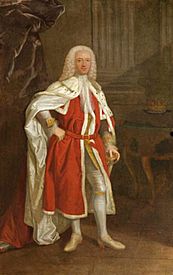James Ogilvy, 5th Earl of Findlater facts for kids
Quick facts for kids
The Earl of Findlater
|
|
|---|---|
 |
|
| Representative Peer for Scotland | |
| In office 4 June 1734 – 20 March 1761 |
|
| Personal details | |
| Born |
James Ogilby
c. 1688 |
| Died | 9 July 1764 (aged 75–76) |
| Spouses |
Lady Elizabeth Hay
(m. 1714, Lady Sophia Hope
(after 1723) |
| Children | Anne Hope, Countess of Hopetoun Lady Margaret Grant James Ogilvy, 6th Earl of Findlater |
| Parents | James Ogilvy, 4th Earl of Findlater Anne Dunbar |
| Residence | Cullen House |
James Ogilvy, also known as the 5th Earl of Findlater and 2nd Earl of Seafield, was an important Scottish nobleman. He was born around 1688 and lived until July 9, 1764. He held several important positions in Scotland during his lifetime.
Contents
Early Life of James Ogilvy
James Ogilvy was born around 1688. His father was James Ogilvy, the 4th Earl of Findlater. His mother was Anne Dunbar. His father was a very important person in Scotland. He was the Lord Chancellor of Scotland, which was like a chief legal officer. He also held the Keeper of the Great Seal of Scotland job under Queen Anne.
His father was given special titles by the King or Queen. These titles included Viscount of Seafield in 1698 and Earl of Seafield in 1701. These titles were part of the Peerage of Scotland, which is a system of noble ranks.
James Ogilvy's Career
In 1715, James Ogilvy was held in Edinburgh Castle. This was because people thought he supported the Jacobites. The Jacobites wanted to bring back the old royal family to the throne. This happened during a time of unrest called the Rebellion.
After his father passed away in 1730, James inherited all his father's noble titles. He became the 2nd Viscount of Seafield, 2nd Viscount of Reidhaven, 2nd Earl of Seafield, 5th Earl of Findlater, 2nd Lord Ogilvy of Cullen, and 2nd Lord Ogilvy of Deskford.
He served as a Lord of Police for Scotland from 1734 to 1742. This role involved helping to keep order and manage public services. He was also chosen as a Representative Peer for Scotland. This meant he represented Scotland's nobility in the British Parliament from 1734 to 1761. From 1737 to 1764, he was the Vice-Admiral of Scotland. This was a high-ranking naval position.
Cullen House During the Jacobite Rising
During another rebellion, the Jacobite rising of 1745, James Ogilvy's home, Cullen House, was attacked. Lord Findlater and his wife were traveling to meet the Duke of Cumberland. The Duke was chasing Bonny Prince Charlie's Jacobite army.
While they were away, some of Charles's supporters broke into Cullen House. They took many valuable things and destroyed what they couldn't carry. A few days later, the Duke of Cumberland arrived with Lord Findlater. They found the house doors broken, windows smashed, and furniture scattered. Lord Findlater later asked Parliament for money to cover his losses. It's not clear if he ever received the payment.
James Ogilvy's Family Life
In 1714, James Ogilvy married Lady Elizabeth Hay. She was the daughter of the 7th Earl of Kinnoull. They had three children together:
- Lady Anne Ogilvy (died 1759), who married John Hope, the 2nd Earl of Hopetoun.
- Lady Margaret Ogilvy (died 1757), who married Sir Ludovick Grant, a Member of Parliament.
- James Ogilvy, 6th Earl of Findlater (born around 1714, died 1770). He married Lady Mary Murray.
After Lady Elizabeth passed away, James Ogilvy married Lady Sophia Hope on December 14, 1723. She was the daughter of Charles Hope, the 1st Earl of Hopetoun. Interestingly, ten years later, Lady Sophia's brother married James Ogilvy's eldest daughter, Lady Anne.
Lord Findlater passed away at Cullen House on July 9, 1764. His son, also named James, became the next Earl. His grandson, James Ogilvy, 7th Earl of Findlater, was known for his work with gardens and for helping others.

